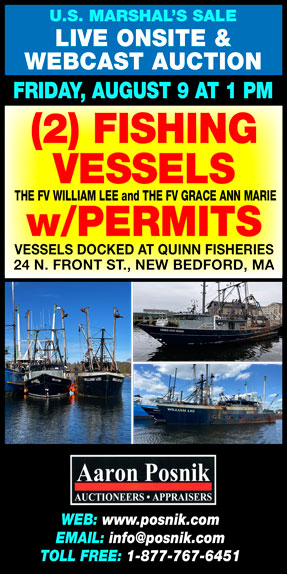Even for the most self-sufficient fishing vessel, the possibility of a disabling mishap at sea due to a storm, grounding, collision, mechanical failure, or some other cause is a fact of nautical life. Your safety and that of your crew depends on your ability to plan for and manage the problems you come against in an environment where mistakes can be not only costly but fatal.
However, keep in mind that while it is a fatal mistake to wait too long to give the order to abandon ship, it may be just as dangerous to abandon ship too soon.

A qualified Coast Guard-approved marine drill instructor, Fred Mattera of Point Judith, RI is the owner/president of North East Safety Training Co. (NESTCo), which conducts fishing vessel drills and inspections and basic safety training workshops.
A commercial fisherman for 40 years, Mattera is a member of the Commercial Fishing Safety Advisory Committee to the Coast Guard, and, since 1998, has been president of the Point Club, a fishing vessel mutual insurance group. He also has served on the board of directors for Sunderland Marine Mutual Insurance Co., the principal underwriter for the Point Club and more than 2,000 US fishing vessels, since 1998.
As long as your vessel continues to float and there is a safe area for persons onboard, including an escape route to the life raft, it remains your best survival platform. Your vessel is more likely to be found by searching aircraft and other vessels than your life raft.
Most importantly, the order to abandon ship must only be given by the captain, and the captain must render this decision when the vessel is in such distress that the lives of the crew onboard are endangered.
An abandon ship call signifies the end of attempts to save the vessel. The life raft is now your best means of shelter.
In an abandonment situation, the first rule is to establish contact with the Coast Guard or another vessel by issuing an immediate mayday. Don’t let pride or panic cause you to delay making that distress call. Next, sound the general alarm to alert crewmembers to gather at their muster stations and begin their assigned survival duties.
Remember to dress for survival. If time permits, put on plenty of warm clothing and a hat, preferably watch cap. Wool or polypropylene clothing is the best. Put on layers even if you will be donning your immersion suit. Extra clothing will extend your survival time by reducing the loss of body heat. Don’t forget that cold, not a lack of food and water, is the greatest killer.
Be sure to have some form of flotation. If you don’t have an immersion suit, wear a PFD. Even the best swimmers have difficulty staying afloat due to the disabling effects of cold water. Know how to don your PFD and immersion suit before you need it.
Launch procedure
Launching the life raft requires a step-by-step procedure to ensure that the raft is secure for ease of boarding.
Your life raft should be in a location where it is easily accessed and capable of floating free in case the vessel sinks before you are able to launch it. The life raft should be secured to its bracket with a strap and quick release attached to a hydrostatic-release mechanism that will free it automatically if the vessel sinks suddenly.
The painter inside and out of the life raft must be attached to the weak link of the hydrostatic-release mechanism.
Here are the initial steps for a simple launch procedure.
- Release the pelican hook (quick release);
- Clear the strap, then pull out 3 fathoms of painter;
- Carry the life raft to the leeside; and
- Tie off the painter.
Most painter lengths are 92′. I recommend that, once tied off, the crew pull out on deck approximately 65% of the entire painter length, thus another 7 fathoms for a total of 10 fathoms (60′).
Now, let’s move on to launching.
- Make sure the water is clear of crew and obstructions.
- Launch the raft 1′ to 2′ past the rail. A little more painter will pay out leaving you 25′ or less to pull until it becomes tight.
- Then, tug on the painter to initiate inflation. The raft will over-inflate in 10–12 seconds so you will hear the sound of air escaping from the pressure-relief valves. This does not mean that the raft is defective. The sound will cease in a few moments.
- Wait for the life raft to fully inflate before boarding. If you board too soon, you may interfere with the life raft’s inflation.
Murphy’s Law
My reasoning for pulling 65% of the painter out on deck is simple. If you launch the raft with 70′ of painter left to pull and get aggressive in launching the raft from the rail – a real possibility with the high stress and anxiety that are natural in abandon-ship situations – there is a good chance the life raft will finally inflate 25′ to 40′ from the vessel.
Pulling the life raft back to the vessel will be difficult once the ballast bags are full of water and the sea anchor has dug in. Before you know it, the crew will be bailing into the water like gannets, swimming mightily to the raft while the tide takes them right by the bow of the vessel never to see the raft again.
The other concern is that, when in peril, Murphy’s Law rears its ugly head. Say the life raft gets entangled in the outrigger bird chain. Now you need to tether a crewman to the vessel, have him jump into the water, grab the painter, pull himself hand-over-hand to the life raft, then board the raft and tie the tethered line to the life lines on the outside of the raft.
Then he has to locate the knife in a sheath that is generally on the right side of the canopy opening and cut the painter at the bird chain, freeing the raft and allowing the crew still aboard to pull the life raft back to the vessel.
Better to follow proper procedure and pull the painter out on deck.
Extra supplies
On a different note, I urge you to consider making up a personal kit of supplies to supplement the survival pack that comes with your life raft and stow it so that it is easy to grab in the event that you have to abandon ship. I recommend the kit include the following items:
- Water;
- Thermal protective space blanket;
- A laser light, flash light, and batteries;
- A handheld VHF radio;
- A coil of light rope;
- A mirror, whistle, knife, waterproof matches, and lighter;
- Duct tape, plastic bags, and binoculars; and
- Candy and high-energy bars.
Also consider packing: medication, spare glasses and/or contact lens, a pad and pencil, hat, and cigarettes for those who smoke to mitigate high anxiety.
Whatever you choose, be realistic. Make sure the kit is manageable and accessible. It won’t do you any good if you don’t have it with you.
In the next SAFE BOAT, we will discuss boarding the life raft.
Fred Mattera
NESTCo
 Read the rest and much, much more in the April issue of Commercial Fisheries News.
Read the rest and much, much more in the April issue of Commercial Fisheries News.
Read online immediately and download for future reference.








 Updating...
Updating...